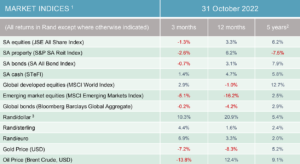Skip to content
Economic and Market Overview – November 2022
Economic and Market Overview
November 2022
October In Review
-
The International Monetary Fund published their bi-annual World Economic Outlook in October. Global growth is forecast to slow from 6.0 percent in 2021 to 3.2 percent in 2022 and 2.7 percent in 2023. This is the weakest growth profile since 2001 except for the global financial crisis and the acute phase of the COVID-19 pandemic. Global inflation is forecast to rise from 4.7 percent in 2021 to 8.8 percent in 2022 but to decline to 6.5 percent in 2023 and to 4.1 percent by 2024.
-
The Federal Open Market Committee of the United States Federal Reserve decided to raise the target range for the federal funds rate to the range of 3.75% to 4% – an increase of 0.75%. They anticipate that ongoing increases in the target range will be appropriate in order to attain a stance of monetary policy that is sufficiently restrictive to return inflation to 2 percent over time.
-
Reuters reported that labour data in the United States once again surprised on the upside. The Bureau of Labour Statistics stated that US employers added 261 000 new jobs in October while unemployment rose from 3.5% to 3.7%. suggesting some loosening in labor market conditions, which would allow the Federal Reserve to shift towards smaller interest rate increases starting in December.
-
In September 2022, China’s trade balance (in US$ terms) recorded a surplus of $84.74 billion, well above market expectations. This increase in the trade surplus occurred as exports increased at a faster pace than imports. On a yearly basis, while exports continued to perform better than imports, both indicators have slowed quite significantly since the beginning of the year. Weaker global demand conditions curbed export performance, while weak confidence and the ongoing zero-Covid policy weighed on domestic demand. China is the world’s second-largest economy so any slowdown in economic activity will have a significant impact on global growth.
-
It took the resignations of two prime ministers and the withdrawal of all the other candidates for Rishi Sunak to become prime minister of the United Kingdom. Sunak is the UK’s first leader of colour and the first Hindu to take the top job. At 42, he is also the youngest prime minister in more than 200 years. The multimillionaire former hedge fund boss is expected to impose deep spending cuts to try to rebuild the UK’s fiscal reputation, just as the country slides into a recession, dragged down by the surging costs of energy and food.
-
South Africa’s Finance Minister Enoch Godongwana delivered his second Medium-term Budget Policy Statement. It struck an optimistic tone and was perceived as “market-friendly”. it was also well-received by rating agencies. Thanks to stronger-than-expected corporate tax collection and despite the severe economic strain of load shedding, rocketing food and fuel prices, interest rate hikes and a looming global recession – South Africa has made some headway in puncturing its ballooning government debt and looks more stable than predicted.
-
South Africa’s headline CPI inflation rose by a modest 0.1% month-on-month, helped by the lower fuel price. However, in the preceding six months inflation averaged a monthly rise of 0.9%. The more modest monthly increase in September resulted in the annual rate of inflation easing to 7.5% for the year, down from 7.6% in August, and a peak of 7.8% in July. It seems likely that the inflation reading of 7.8% in July was the peak in inflation for the current business cycle. Despite this slowdown in inflation, the South African Reserve Bank is expected to continue increasing interest rates.

- Source: Factset
- All performance numbers in excess of 12 months are annualised
- A negative number means fewer rands are being paid per US dollar, so it implies a strengthening of the rand.
Page load link

